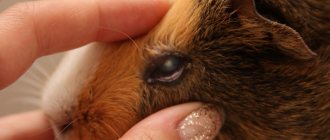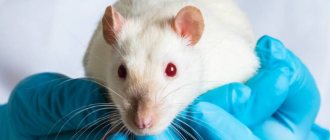Why do hamsters have red eyes? A few simple answers to your question
The most common are the cute Djungarian and Syrian hamsters with long hair.
Therefore, the red eyes of a hamster become quite unusual and repulsive for us. Some people who are not familiar with the distinctive features of the breed mistakenly assume that a hamster with red eyes has some kind of pathology and is sick. Don't rush to conclusions, you just need to figure it out. Such animals are capable and produce healthy offspring. The main thing is to determine the cause of the rodent’s unusual eye color.
What complications can occur after cataract surgery?
Complications after surgery can vary and depend on how thoroughly the patient prepared for cataract removal. That is why we ask for a wide range of tests and expert opinions so as not to miss an alarm signal and minimize complications. It also directly depends on the preparation for the operation - whether the patient has followed all the recommendations. And from maintaining hygiene after replacing the lens. If the patient has completed all the preparatory steps and doctor’s prescriptions, there are usually no complications and the results of the operation are pleasing to the patient, his family and us.
Takhchidi H.P. et al. Intraocular correction in surgery of complicated cataracts. – M.: Publishing house “New in Medicine”, 2004.
Khodzhaev N.S. Cataract surgery using small incisions: clinical and theoretical justification: Dis. ...Dr. med. nauk.- M., 2000.
Breed Features
Red eyes are considered normal only in hamsters of a certain coat color - white. They are similar in appearance to each other, but differ greatly from the usual pigmentation of the coat. The color is uniform, it does not have dark inclusions or other shades. Its snow-whiteness only emphasizes the redness of the eyeballs.
Below we will answer two of the most popular questions regarding the health of a small pet.
Why do albino hamsters have red eyes?
Sometimes it turns out that the most common rodent parents (in particular, Syrian hamsters) give birth to offspring whose fur has no pigmentation at all. The idea that albinos are a separate breed is erroneous. Such cubs are born among any breed. This is due to some genetic mutations, which in turn do not affect the behavior or health of hamsters.
Albino fluffies are considered very valuable representatives of the family, because it is almost impossible to breed them artificially. The uncharacteristic color is the result of the fact that the body of these rodents does not produce melanin, which is responsible for pigmentation. Because of this, blood vessels and capillaries are visible through the transparent membrane of the eyes.
It is quite difficult to meet albinos in the wild, because they fall prey to predators (their white color gives them away), but at home such a pet can live for about four years.
White hamsters with red eyes are slightly different from their relatives in size and character. The Djungarian albino hamster can be quite aggressive towards other representatives of the breed, while the Syrian is larger in size, but it easily gets used to hands and is unpretentious.
Why do hamsters have yellow teeth?
This question also worries the owners of these cute fluffies. This is not a disease, but a norm. Since rodents' teeth grow constantly, the animals have to grind them down on their own. Because of this, the protective layer of enamel on the incisors increases, making them stronger. The yellower the teeth, the stronger they are.
Rodents' teeth are not brushed, but every six months he needs to be taken to a dentist for a dental examination.
What should you be wary of?
Hamster diseases can also answer the question - why does a hamster have red eyes. This applies to animals that do not initially have white fur, so it is necessary to take your pet to a veterinarian for examination.
In this case, treatment is most often required, because redness and swelling may indicate not only mechanical irritation, but also be a manifestation of diseases of other organs.
An obvious ailment is the animal's blindness - congenital or acquired. It can be diagnosed independently: the rodent moves little, and the eyes fester or swell. If you consult a doctor at the initial stage, vision can be restored with medication.
But this is not the only danger. The protrusion of the eyes of these animals causes infections to enter the body. Even walking through a dusty room or living in unkempt cages for hamsters causes conjunctivitis.
- eye redness and swelling;
- purulent discharge;
- drowsiness and lethargy of the animal.
Advice! Regular cleaning of premises will help avoid this inflammation.
Self-treatment without a medical examination can only worsen the situation. It is better to take care of your pet using other methods: clean the cage and wheel with antiseptic solutions and provide proper nutrition (whole grains and chicken meat). Use special eye drops at the prescribed time as prescribed by your veterinarian.
Here they are - breeds of hamsters with red eyes. If you were wary of them before, now you know that this is a rare gift, and you will be lucky enough to become the owner of an albino.
How are patients monitored?
Each patient after surgery is assigned individual postoperative observation. On average, you will need to see a doctor 4-5 times. But in some cases it’s more – it all depends on the specific case. Visits to the doctor are scheduled once a week. It is highly recommended not to skip the post-operative examination prescribed by your doctor. If the patient nevertheless missed or did not show up at the appointed time, you need to understand that responsibility for the consequences falls on him. In this case, we record that the patient did not show up for the consultation at the appointed time, make a note on the card, and call to find out the reason for the absence.
Eye diseases in hamsters
Due to their natural characteristics, eye diseases are very common in hamsters. The owner must be able to provide first aid to the pet and know what to do if the hamster’s eye does not open.
The eyes of night rodents are large and convex, which gives them a charming appearance and allows them to notice a predator in time. But physiological exophthalmos (bulging eyes) significantly reduces the protection of the organ of vision. The hamster can easily injure it or prick itself due to a delayed blink reaction. The central zone of the cornea is poorly washed by tears and is little wetted, so even a minor injury can lead to an ulcer. Hamsters are active at night and are not adapted to bright light. A bright flash or direct sunlight can damage hamsters' already weak vision.
Due to the pet’s small size and independent nature, the owner often discovers the problem in an advanced stage: the hamster has one eye closed, or both eyelids are glued together with pus, one is larger than the other, and so on.
Why is conjunctivitis dangerous?
Conjunctivitis for hamsters is not at all the same as for humans. If a person can cope with this problem in a few days with the help of eye drops, then your pet does not have the opportunity to overcome the disease on its own. For this reason, you need to be wary if you notice at least one of the signs of conjunctivitis. It is worth considering that conjunctivitis, as a rule, is the very beginning of the pathology. Without taking appropriate measures, conjunctivitis will quickly turn into keratitis, followed by ulceration of the cornea of the eye. If a hamster's eye is swollen, but the owner does not pay any attention to it for a long time, then the rodent may go blind and then die.
The same dangers await the pets of their owners, who not only do not pay attention to the problem, but treat the pet incorrectly.
Under no circumstances should you self-prescribe pills to your pet or, even worse, give injections. This should only be done by an experienced veterinarian.
If you prevent your hamster from getting sick or detect it in time, you won’t have to think about why your hamster’s eye popped out and how to help him in such a situation. Often, due to late detection of the disease, pets completely lose their vision.
Non-inflammatory diseases
Cataract
If your hamster's eye is cloudy, it could be a cataract - a metabolic disorder in the lens. The disease leads to
blindness. Eye drops are not effective, and surgery is not performed in either the Djungarian or the larger Syrian hamster. When the owner notices that the hamster's eye has turned white, this is a reason to consult a doctor, despite the fact that there is no treatment. Cataracts in a hamster are a sign of old age, decrepitude of the body, and in a dwarf or Campbell's hamster it is an indirect sign of diabetes. In both cases, treatment of the underlying disease is required to prolong the pet's life.
A thorn on the surface of the cornea is not a cataract, but the consequences of an injury, a scar. With cataracts, something light is visible in the depths, in the area of the pupil.
Glaucoma
An increase in intraocular pressure is accompanied not only by enlargement and bulging of the eyeballs, but also by severe pain. A doctor makes a diagnosis of glaucoma after measuring the pressure in the eye. It is not possible to normalize it with drops; the only treatment is enucleation to stop the pain. If you don't do anything, the eye will eventually burst. It is difficult to say why such a pathology occurs. Since Campbell's hamsters are most often affected, rarely Djungarians and never Syrians, a genetic (hereditary) nature is assumed.
How to treat eye diseases
Usually the owner notices the problem of eyeball prolapse when the symptoms become more pronounced. Sometimes in such circumstances the affected eye is difficult to save, but you should fight for the second and, possibly, for the life of the rodent.
It is best to take a sick hamster to a veterinarian as soon as possible so that he can make the correct diagnosis, prescribe antibiotics, or perform other procedures and operations. In some cases, treatment may last up to 2 weeks or longer depending on the severity of the lesion.
Important! Do not use antibiotics that are in your home medicine cabinet. Hamsters are different from humans and not only require different doses, but also metabolize medications differently than humans.
Usually the doctor prescribes 0.3% eye drops “Gentamicin”, “Albucid”. The solution should be administered to rodents according to the instructions: usually 3-4 drops per day. But it is advisable not to self-medicate, so as not to aggravate the situation.
At home, you can use a solution of boric acid (1 teaspoon per 100 ml of boiled and cooled water) to wash the eyes, cleanse crusts and relieve irritation. Using a dropper, apply drops to your eyes 2-3 times a day. If there are no signs of recovery within 2-3 days, you should contact your veterinarian, as more serious health problems may arise.
To clean wounds and soak away crusts on the eyelids, you can use a saline solution, which is distilled salt water and has almost the same structure as tears.
Here's how to make your own saline solution:
- 250 ml of distilled or boiled and cooled tap water;
- 2.5 g table salt;
- 2.5 g baking soda.
The prepared product should be stored in a clean glass jar for no longer than 24 hours. When carrying out hygienic procedures, you need to dip a clean cotton pad or swab into the solution and wipe the eye in the direction from the inner corner to the outer. Use clean material for each wash. To prevent the hamster from transferring the infection from one eye to the other while washing, both need to be treated, even if signs of the disease are noticed in only one.
Try not to get your pet wet - a wet hamster takes a long time to dry and can easily get sick. If necessary, specialists perform eye removal operations under short general anesthesia.
Also find out what to do if your hamster dies.
Common hamster diseases and their treatment
Like all living creatures, hamsters are susceptible to disease. Their life is short, and the disease in hamsters always progresses very quickly. Therefore, it is important to notice in time that something is wrong with your pet and quickly provide help. Find out in advance where the veterinarian who treats ornamental rodents sees you. It would be a good idea to study the symptoms of diseases to which hamsters are susceptible. This will not only increase the chances of saving the baby, but will also help avoid infection yourself. After all, a person can become infected with many diseases from animals. People can get the same disease that hamsters get. This article tells you what diseases afflict Syrian, Djungarian, Campbell and other breeds of hamsters.
Classification of diseases
According to the type, hamster diseases, like those in humans, are divided into contagious and non-contagious. The following diseases are contagious.
- Bacterial infections. Cause gastrointestinal, skin and other inflammatory processes.
- Viral infections. They affect the eyes and mucous membranes and cause tumors.
- Fungal. Mainly they cause skin diseases.
- Infection with parasites (fleas, ticks, worms).
Some of these diseases can be transmitted to people. You need to be extremely careful when contacting a sick animal and take it to a veterinarian as quickly as possible. Only a doctor, after performing tests, will make a final diagnosis and give a prognosis for the possibility of recovery. Unfortunately, many diseases are fatal to a hamster. But in any case, a loving owner will do everything in his power to ensure that the hamster recovers.
Non-communicable diseases include non-communicable diseases.
- Injuries and bruises caused by falling from a height or fighting with other cage occupants.
- Metabolic disease. For example, diabetes mellitus, which most often affects Djungarian hamsters.
- Diseases caused by stressful situations. These include heart disease, heart attacks, and strokes.
Diseases in Syrian hamsters are most often associated with gastrointestinal infections.
Causes of cataract development
There are several theories about the pathogenesis of cataracts, but none of them gives a clear and unambiguous picture. The largest number of specialists prefer the theory of free radical oxidation. Predisposing factors for the development of acquired disease may be the following:
- Elderly and senile age;
- Recurrent inflammatory processes of the eyes;
- Fuchs syndrome, in which there is dysfunction of the ciliary body and iris;
- Glaucoma;
- Severe general infectious diseases;
- Some dermatological diseases, for example, eczema, scleroderma;
- Mechanical, chemical and thermal eye injuries.
Congenital cataracts are often the result of toxic effects on the fetus of infections and certain medications. It can also be a sign of hereditary syndromes.
When to sound the alarm
How to understand that a hamster is sick. If the animal is healthy, it is active, it has smooth shiny fur, clear, clean eyes and a good appetite. But if you notice that your pet is behaving unusually, take immediate action. Your hamster is sick if some of the following symptoms are noticeable:
- eats poorly or refuses food altogether;
- eyes become watery or festering;
- frequent loose stools;
- constipation, dry stool or no stool at all;
- blood dripping from the anus;
- difficulty or hoarse breathing, cough;
- nasal discharge or excessive drooling;
- wet or dull, matted fur;
- ulcers, wounds, peeling skin, bald spots on the skin;
- tumors, bloating;
- lethargy, low mobility;
- the hamster is trembling, although the room is warm.
An animal's underweight may also be a sign of illness. To find out if your pet is sick, weigh your pet periodically. The weight of an adult Syrian is about 90 g, the weight of a Djungarian is at least 30 g.
What tests need to be taken before lens replacement surgery? Which doctors should I go to?
Before the operation we require without fail:
- Complete blood count + ESR + platelets. Valid for 10 days.
- Blood sugar. Valid for 10 days.
- RW (syphilis). Valid for 1 month.
- Hepatitis B and C. Expiration date: 3 months.
- HIV. Valid for 3 months.
- Fluorography (x-ray of the lungs). Valid for 1 year.
- ECG. Valid for 1 month.
- Dentist consultation. Valid for 1 month.
- ENT consultation. Valid for 1 month.10.
- Consultation with a therapist. Valid for 1 month.
- If you have a history of diabetes mellitus, consult an endocrinologist. Valid for 1 month.
Why so many tests?
Contagious diseases in hamsters
An animal can become infected with a bacterial or viral infection in several ways.
- From other sick animals through direct contact or through its waste products.
- Through contaminated food or water.
- Insect bites.
- Through litter and uncollected excrement.
Respiratory infections are activated by hypothermia, stress and lack of vitamins in the body. You can tell that a hamster is sick by its behavior. He will become lethargic and apathetic. You may notice discharge from the nose. The young, strong hamster will recover in a few days. In weak individuals with reduced immunity, the disease can develop into pneumonia. The animal will cough and breathe heavily. In a few days he will die.
Tuberculosis develops in a weakened body when the tuberculosis bacillus enters the body. There are two forms of this disease, depending on the method of infection: pulmonary and intestinal. With the pulmonary form of tuberculosis, the hamster experiences a cough, shortness of breath, and decreased appetite. The intestinal form is characterized by severe diarrhea. This disease of hamsters, unfortunately, is incurable.
To prevent tuberculosis, the animal must receive adequate nutrition with the required amount of vitamins, the cage must be kept clean at all times, and the room must be periodically ventilated. It is necessary to avoid contact with sick animals and people. Not only can humans become infected with certain illnesses from a hamster, but rodents can also suffer from contact with a sick person.
Colibacillosis is an infectious disease of the gastrointestinal tract caused by Escherichia coli. Characterized by very severe diarrhea. The stool is so thin that it looks more like urine, which is why the disease is also called “wet tail.” The hamster becomes lethargic, eats poorly, and quickly loses weight. If you notice such signs, you should urgently take the rodent to the veterinarian. The doctor will examine the symptoms and prescribe treatment. Antibiotics of the tetracycline group are usually prescribed and added to food or drinking water. In severe cases, chloramphenicol injections are prescribed.
Colibacillosis is a highly contagious disease. If the sick animal has been in contact with other pets, they will also have to be treated. The sooner you see a doctor, the more successful the treatment will be. Prevention of the disease - maintaining cleanliness in the cage. As well as keeping each animal in a separate cage.
Types of cataracts
Cataracts are divided into congenital and acquired. Congenital cataracts come in different origins: hereditary (of a family nature), others are a consequence of intrauterine pathology. Thus, the cause of congenital cataracts in children can be hypocalcemia, hypothyroidism, and maternal diabetes during pregnancy. Toxoplasmosis and viral infections (rubella) in pregnant women lead to many congenital anomalies, including clouding of the lens.
Acquired cataracts are distinguished: age-related (more often occurring in people over 50 years old), cataracts arising against the background of general diseases (diabetes, collagenosis, etc.), complicated cataracts arising against the background of eye diseases (myopia, glaucoma, uveitis, etc.), and also radiation and traumatic cataracts.
In addition to dividing into congenital and acquired, cataracts are divided into stationary (non-progressive, with some exceptions - congenital) and progressive (almost all acquired). Cataracts are also divided according to their localization: layered (zonular), anterior, posterior, polar, nuclear, fusiform, cortical, stellate, etc.
Based on the severity of lens opacification, cataracts are classified into: initial, immature, mature and overmature cataracts.
Non-communicable diseases
Non-contagious diseases of Djungarian and other breeds of hamsters primarily include injuries. They are injured mainly due to the fault of their owners. Rodents should not be allowed to walk on a table or other surface from which the homa could fall. When purchasing and installing a running wheel, it is necessary to exclude narrow (less than 0.5 cm) gaps so that the baby does not stick his paw in there and injure himself. If you have several dwarfs, place them in different cages. Otherwise, they will fight and may also injure each other.
Poor nutrition may be the cause
- dental diseases;
- inflammation of the cheek pouches;
- food poisoning;
- hemorrhoids (if blood drips from the anus, your pet may have a fissure there).
Non-communicable diseases also include complications of pregnancy and pathological childbirth in females. Sometimes blood under the female's tail appears as a result of a miscarriage.
Cataract treatment
In the early stages, conservative treatment is carried out using drugs in the form of drops to restrain the progression of the process. The drops contain substances that either increase the energy level of functioning of the lens structures or protect them from the harmful effects of products of impaired metabolism of amino acids such as tryptophan and tyrosine. However, the main method of treatment remains surgical. Extraction (or extraction) of the cloudy lens from the eye cavity. Today, the optimal operation is cataract extraction through a small (from 1.5 to 3.5 mm) incision with simultaneous implantation of a foldable IOL (intraocular lens) made of a hydrophobic polymer material with shape memory into the capsular bag of the lens. Ultrasound energy is used in combination with the impact of a sound wave to destroy the nucleus of the lens. Make an appointment
Metabolic disorders
Metabolism is the proper functioning of all body systems. Food processing, energy production, removal of unnecessary and harmful products. The central nervous system is responsible for all this, but the glands that secrete hormones have a huge influence on metabolic processes. These include the thyroid and pancreas, adrenal glands, pituitary gland, and gonads. Poor nutrition, poor environment, and hereditary factors affect the functioning of these organs. Violation of their normal functioning leads to a malfunction of the body as a whole. Diseases of Djungarian hamsters are often associated with metabolic disorders.
Diabetes mellitus can develop due to excessive consumption of carbohydrates. Hereditary predisposition to the disease also plays a role. You can find out that a hamster has contracted this disease by the characteristic smell of acetone, which comes from the rodent's saliva and urine. But only a doctor can make a final diagnosis by doing a blood test. Prevention of disease in Djungarian hamsters is a balanced diet, eliminating sugar from the diet, good care and an active lifestyle.
Stroke can also be classified as a disease that occurs due to metabolic disorders. With age and as a result of poor nutrition, cholesterol plaques are deposited on the walls of blood vessels, which prevent the normal passage of blood. At some point, the plaques completely block the vessel, it bursts, and hemorrhage occurs.
If your hamster is shaking or having convulsions, the end is probably near.
Sometimes attentive owners are concerned that the rodent has a yellow sore on its stomach. In fact, this is a scent gland, with the help of which the male marks his territory.
What happens if cataracts are not treated?
Cataracts will inevitably progress, even with the use of the most modern medications. Degenerative processes will lead to disruption of the structure of the lens, its clouding and delamination. Eventually, the cataract will enter an overripe stage, when the fibers of the lens disintegrate, its cortex liquefies, the nucleus loses support and sinks down. The result is complete blindness. In addition, complications are possible, for example, the development of glaucoma due to occlusion of the outflow tract of intraocular fluid, or rupture of the lens capsule and release of detritus with the development of the inflammatory process.
Diseases caused by stress
Stress factors for a small rodent can include loud screams, the operation of various electrical appliances, other pets and much more. Diseases that develop as a result of stress in Syrian and other breeds of hamsters:
- eczema (ulcers and peeling of the skin, hair loss);
- heart attack, cardiac arrest;
- complete or partial paralysis (can occur if the animal is very frightened).
To avoid such troubles, never yell at your baby or punish him for any pranks. Do not place the cage near a TV or speakers. Isolate the rodent from cats and dogs if they live in your home. If you just acquired a furry puppy, give him a few days to get used to his new place of residence, do not immediately start playing with him or raising him.
When should cataract surgery be performed?
Radical treatment of cataracts is possible only surgically - the lens is removed and replaced with an artificial one. Modern technologies make it possible to perform the procedure without waiting for the cataract to mature, which allows you to preserve vision. Indications for surgery are the following factors:
- Intumescent cataract;
- Mature and overmature cataracts;
- Subluxation or complete dislocation of the lens;
- Presence of concomitant eye pathology;
- Persistent decrease in vision.











